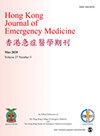Anticoagulant rodenticide ingestion: Who will develop coagulopathy?
IF 0.8
4区 医学
Q4 EMERGENCY MEDICINE
引用次数: 0
Abstract
Introduction: Development of coagulopathy after anticoagulant rodenticide ingestion varies among patients. This study aimed to identify factors that were associated with coagulopathy after anticoagulant rodenticide ingestion. Methods: This was a retrospective cohort study, conducted in the Hong Kong Poison Information Centre. All patients who reported rodenticide exposure and presented to the Accident and Emergency Department from 1 January 2010 to 31 December 2019 were recruited. Coagulopathy was defined as International Normalized Ratio of 1.3 or above. Results: One hundred sixty-nine patients were included in the final analysis. The median age was 44 years old. Forty-nine patients developed coagulopathy (International Normalized Ratio ⩾1.3). Univariate analysis (at p < 0.05) showed that age (p = 0.003), ingestion of first-generation anticoagulant rodenticide (p = 0.017), ingestion of more than one pack (p < 0.001), intentional ingestion (p = 0.002), hypoalbuminemia (p < 0.001), elevated alanine aminotransferase level (p = 0.041) and abnormal estimated glomerular filtration rate (p = 0.005) on presentation, and co-ingestion with paracetamol (p = 0.018) were associated with coagulopathy after anticoagulant rodenticide ingestion. Among these, ingestion of more than one pack (p < 0.001; odds ratio = 19.8; 95% confidence interval = 6.78–65.7), ingestion of first-generation anticoagulant rodenticide (p = 0.006; odds ratio = 5.2; 95% confidence interval = 1.96–15.2), hypoalbuminemia (p < 0.001; odds ratio = 22.4; 95% confidence interval = 6.17–99.0) and elevated alanine aminotransferase level on presentation (p = 0.039; odds ratio = 7.11; 95% confidence interval = 1.58–33.1) were statistically significant in the multivariate analysis. Conclusion: Ingestion of more than one pack and ingestion of first-generation anticoagulant rodenticides were significantly associated with the development of coagulopathy after anticoagulant rodenticide ingestion. Patients who developed hypoalbuminemia or elevated alanine aminotransferase level as a result of anticoagulant rodenticide ingestion were also significantly associated with the development of coagulopathy.摄入抗凝剂灭鼠剂:谁会发生凝血病?
引言:服用抗凝血灭鼠剂后凝血障碍的发展因患者而异。本研究旨在确定摄入抗凝血灭鼠剂后凝血障碍的相关因素。方法:这是一项在香港毒物信息中心进行的回顾性队列研究。招募了2010年1月1日至2019年12月31日期间报告接触灭鼠剂并向急诊科就诊的所有患者。凝血病定义为1.3或以上的国际标准化比值。结果:169名患者被纳入最终分析。中位年龄为44岁 岁49名患者出现凝血障碍(国际标准化比率⩾1.3) < 0.05)显示年龄(p = 0.003),摄入第一代抗凝血灭鼠剂(p = 0.017),摄入一包以上(p < 0.001),故意摄入(p = 0.002)、低白蛋白血症(p < 0.001),丙氨酸氨基转移酶水平升高(p = 0.041)和异常估计肾小球滤过率(p = 0.005),并与扑热息痛共同摄入(p = 0.018)与摄入抗凝血灭鼠剂后的凝血障碍有关。其中,摄入超过一包(p < 0.001;比值比 = 19.8;95%置信区间 = 6.78–65.7),摄入第一代抗凝血灭鼠剂(p = 0.006;比值比 = 5.2;95%置信区间 = 1.96-15.2)、低白蛋白血症(p < 0.001;比值比 = 22.4;95%置信区间 = 6.17–99.0)和丙氨酸氨基转移酶水平升高(p = 0.039;比值比 = 7.11;95%置信区间 = 1.58–33.1)在多变量分析中具有统计学意义。结论:摄入多包和第一代抗凝血灭鼠剂与摄入抗凝血灭鼠药后凝血障碍的发生显著相关。由于摄入抗凝血灭鼠剂而出现低白蛋白血症或丙氨酸氨基转移酶水平升高的患者也与凝血障碍的发展显著相关。
本文章由计算机程序翻译,如有差异,请以英文原文为准。
求助全文
约1分钟内获得全文
求助全文
来源期刊

Hong Kong Journal of Emergency Medicine
EMERGENCY MEDICINE-
CiteScore
1.50
自引率
16.70%
发文量
26
审稿时长
6-12 weeks
期刊介绍:
The Hong Kong Journal of Emergency Medicine is a peer-reviewed, open access journal which focusses on all aspects of clinical practice and emergency medicine research in the hospital and pre-hospital setting.
 求助内容:
求助内容: 应助结果提醒方式:
应助结果提醒方式:


